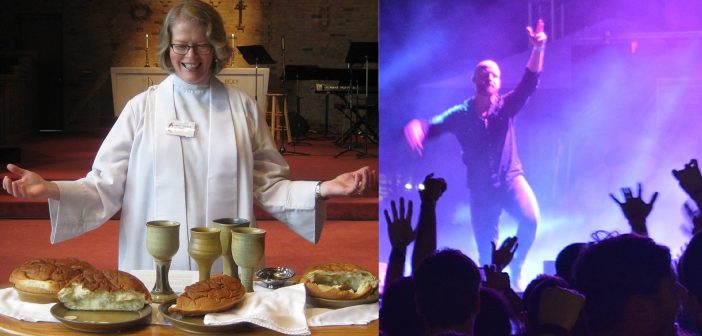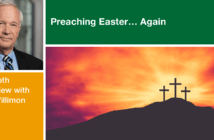L. Roger Owens and Donna Claycomb Sokol, authors of New Day in the City, say re-imagining worship to better reach new people involves more than asking if they prefer a traditional, contemporary, or blended style. The starting point must be a clear understanding of the theological purpose of worship. Then, asking how your worship engages your cultural context and your worship participants.
For years, many congregations have battled over which style of worship to embrace — traditional, contemporary, or blended. But this “worship war” is premised on a misunderstanding of what those outside our congregations seek from worship, and deep confusion about what worship really is. Flourishing and faithful congregations understand that re-imagining worship involves something much deeper than style.
Congregations seeking renewal need to ask questions more foundational than the worn-out questions about what style of worship people want.
How does the worship-style debate relate to those beyond our congregations?
Often, adding a contemporary service will attract the people the congregation hasn’t been able to reach with its current worship service. But what does this suggest about the people who might show up for the first time? That they already know what worship is and what they want in worship. These people are those who are switching churches, or who have left a church because the style of worship hasn’t met their preferences. They are people who think worship should cater to their tastes and are shopping around. When we advertise a new contemporary service or put on our billboards the times of different styles of worship, we are inviting a particular type of worshipper to join us. An informed consumer. Such a strategy might get a few new people to show up, but it does little to help a congregation introduce non-Christians to life with God and in God’s kingdom.
The purpose of worship
Perhaps even worse, the obsession with style and the belief that adding a service of a different style is the silver bullet to reverse decline show a deep misunderstanding of worship. The purpose of worship is not to give people ignorant of the faith their first introduction to Christianity. Rather, worship aims to orient our lives — all that we are and do — in the direction of the God in whom we live and move and have our being. This purpose of worship can be fleshed out with three declarations:
- Worship is the place where we enact our core human purpose, the end for which we exist, to worship and glorify God.
- Worship is the place where we have our vision trained to see the signs of God’s in-breaking kingdom.
- Worship is the place where the community remembers its identity as God’s called, gathered, and sent people.
Worship obsessed with matching a particular style to people’s shallow preferences does none of these things. In fact, it does just the opposite: it reinforces the disorder of lives that believe that their own preferences are at the center.
Key questions for congregations seeking renewal in worship
Congregations seeking renewal need to ask questions more foundational than the worn-out questions about what style of worship people want. Congregations seeking faithful renewal in worship need to ask:
1. Is our worship deeply contextual?
While the gospel challenges any consumerist approach to worship that evaluates worship based on shallow, changing preferences, the gospel has always been enculturated, contextual. It is always embodied and expressed in the culture in which it seeks to take root. Music, language, and other forms of expression imported in an attempt to emulate “successful” congregations often don’t fit. Those planning and leading worship can’t pay too much attention to what ways worship is being expressed through the language, images, idioms, and other embodiments of the culture of the congregation and the city in which it lives.
2. Is our worship deeply visual?
One key cultural phenomenon facing the vast majority of congregations is the re-assurgency of the image. Walk through any city center and you will be overwhelmed with the visual display — its immediacy, power, and brilliance. The Reformation, with its emphasis on the words of Scripture, ushered in an era of visually sterile churches. But we ignore the power of image to our peril. Worship that is forming people who can see God’s kingdom will learn to use images to shape the imaginations of people present.
3. Is our worship highly participatory?
This might be the most important question, one that encompasses the previous two. Does our worship invite people to bring, offer, and engage their whole selves in worship — body, mind, and heart? Are those gathered for worship actively involved, and are all their senses engaged? Do they get to touch the water, gaze upon the icons, approach the altar, adopt postures for prayer, and connect physically with their neighbors? Or do they sit and observe, while the clergy perform the acts of worship?
Sitting in your pews or seats on Sunday morning are musicians, artists, decorators, computer programmers, storytellers, comedians, writers — the gifts are endless. What are the elements of a worship service these people could help create? Don’t be afraid to think outside the box. There’s no better way to have appropriately contextual and deeply participatory worship than to have worshipers themselves use their gifts to create the elements of worship.
Some people might think to stop here, but we suggest taking it a step further. Don’t look only within the congregation. Look around the city and find the culture-makers within the community. What are they doing and creating that can find a place in Christian worship? These creative voices can help us renew worship from the ground up.
The article is adapted from A New Day in the City: Urban Church Revival (Abingdon Press, 2017) by Donna Claycomb Sokol and L. Roger Owens. Used by permission. The book is available at Cokesbury and Amazon.
Related Resources
- Leadership for Worship by Lovett H. Weems, Jr
- Considering the Context of Worship by Jacob Armstrong
- Moving Beyond Personal Preferences into Missional Thinking by David Putman and Ed Stetzer
- Post-Modern Pilgrims by Leonard Sweet







